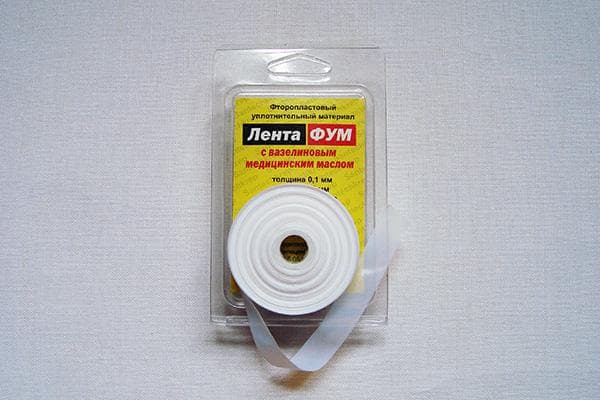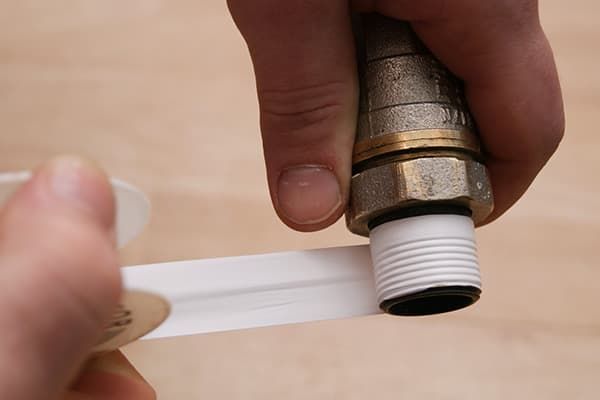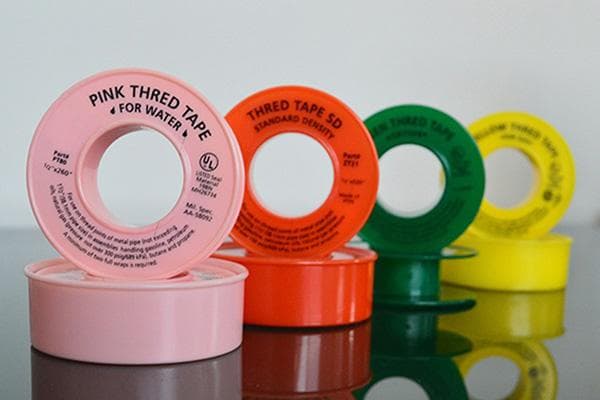How to use FUM tape correctly: advice from a plumber
The tightness of the connections is an important indicator of the quality of work of a plumber or gas fitter. It is necessary to wind the FUM tape correctly: avoid distortions, observe the winding direction, and do not make mistakes with the amount of tape. Mistakes in this matter are fraught with problems with the connection: it will either begin to leak, because the fitting will crack when tightened. Let's figure out how to properly seal threads with FUM tape and what is required for this.

What is FUM tape?
The abbreviation “FUM” is derived from the name of the material (fluoroplastic, i.e. polytetrafluoroethylene polymer) and its purpose (sealing material). The abbreviation quite fully describes the means for sealing joints. This is a strip of white (sometimes beige) polymer film. By wrapping it around the threads, they prevent moisture or gas from leaking through the connection.
FUM tape appeared as a replacement for previously used sealing materials: tow, linen cords, paint-impregnated bandages and other natural-based materials. To assess the feasibility of using a new type of sealant, you need to have a good understanding of the strengths and weaknesses of the fluoroplastic polymer.
Advantages and disadvantages of the material
The main advantage of the tape, which was immediately appreciated by plumbers and gas workers, is its simplicity and ease of use. It does not need to be coated with water-repellent pastes, paint or other substances, therefore the time required to create each connection is reduced.Plus, you don't have to get your hands dirty.
Other advantages of this seal include:
- Resistance to aggressive substances. Even solutions of chemically active substances flowing through pipes sealed with fluoroplastic sealant will not destroy the packing.
- Resistance to low and high temperatures. Fluoroplastic polymer does not lose elasticity at temperatures from -50 °C to +210 °C.
- Unsuitable for the development of microorganisms. Mold does not grow on the surface of the film, and this material is also not damaged by bacteria.
The tape can be used to seal threaded connections on pipelines made of plastic, metal or metal-plastic elements.
There are also some disadvantages. First of all, the tape is not applicable for pipelines with large diameters (50 mm or more). On massive threads, a layer of film of 0.1–0.2 mm will not provide water impermeability. In addition, it is not advisable to turn connections sealed with this sealant. Otherwise, the thread will cut the material with a sharp edge, opening the way for water.
Types of tape: choosing the right one
The first secret you need to know in order to use fluoroplastic sealant correctly: there are three types of tape. Each of them is designed for specific types of pipeline. Here is their brief description:
- To achieve tightness of threaded connections of pipes in which aggressive liquids will flow, use FUM-1 film. It is coated with a special lubricant that improves the quality of sealing and facilitates assembly.
- FUM-2 material is intended for systems through which oxidizers are supplied. It contains no lubricant.
- If the environment does not contain oxidizing agents, alkalis or other aggressive substances, FUM-3 film is suitable.It is also available without lubrication.
Just as important as the type of material is the width of the strip. It must strictly correspond to the width of the thread. Therefore, all three varieties are available in several different sizes.
If the type of film or strip size is chosen incorrectly, it will be very difficult to make the threads impenetrable.
Connection sealing technology
Another condition for obtaining a good result is compliance with the joint sealing technology.
The work is performed in the following order:
- Cleaning the threads from dirt and oxides. Clean metal threads with a wire brush. The final stage is wiping the parts with a rag soaked in solvent to remove the grease film.
- Selection of film by type and width. The edges should not extend beyond the thread boundaries. A variety that is too narrow is also not suitable: when wound at the overlap, the layer will be thicker, and thinner at the edges.
- Winding the tape. The turns are made strictly clockwise, with sufficient tension so that the material fits tightly onto the thread, but does not cut through.
The tape cannot be rewinded. If the coil does not lie correctly during winding, you will have to remove the entire material and rewind it again.
To work correctly with FUM tape, some skill is required. If you have never used this material before, be sure to practice before assembling the joint (do several test windings). The effort will pay off - you will be able to create neat, waterproof joints with minimal effort.


We use joints sealed with a foam on a diameter of 108 mm. No problem. The main advantage is ease of use and ease of disassembly. If you want the most reliable connection, flax and only flax. With special paste. Then you can turn it around.
So he got high in shit when he told me how to use FUM.
yeah, quickly, clean bye, pick up, I'll do it faster with tow
And then your quick twist will snot and if somewhere in the middle of the assembly, then everything will have to be disassembled and twisted. Until the flax and paste are in good condition, you cannot start the connection, but you can do it with FUM tape. and speed is only needed when catching a flea... F*** a buggy wife, and this is water and plumbing accidents are worse than an electrical accident..
oil workers screw the Xmas tree onto casing tubes (with a diameter of more than 300 mm) using a 100 mm wide FUM tape
When lowering the casing, this tape and special rattling lubricant have not been used for a long time.
Not a single normal plumber ever uses any tape; they use flax with high-temperature paste.
Yeah, especially when drinking)) Then the month will be like in a ditty.
I loved the tractor driver
I gave it to the tractor driver
Three weeks of soapy boobs
And diesel fuel pissed..
In drinking water supply systems, inert seals, FUM, Tangit, etc. are still better.
Then we need to write and how to use toilet paper. Teachers are fed up
Thanks to the author. Not everyone is as cool as the first commentators.
on the "clave" they knock cool. better than “fum” has not yet been invented, especially for gas and especially on the street, where after 2 years all the “flax” needs to be changed. you need to choose the right tape.
Well, you're clueless. Fum dangles like flax on the other hand, I didn’t bother to read the rest of the nonsense about Chinese fum. Since the Baltic year nine hundred, fum is fum; for the profane, the Chinese decorated it with felt-tip pens.
Let me clarify: the fum roller needs to be turned over, unlike in the picture, then you can put it on your finger and easily make the maximum tension, unless, of course, the fum is domestic and not Chinese. During the Soviet Union, fum was used for gasification and cold water supply.
Dear, FUM tape for sealing gas pipes, etc. But not for water. Or together with tow.
FUM is suitable for sealing exclusively conical threads. No need to spread misinformation. The borehole pipes that were mentioned mostly have tapered threads.
Almost all plumbers are inherently HAND-ASS, so you have to do everything yourself.
yeah exactly on target!!!!!!????
Monk, you are wrong, all plumbers are divided into two categories, the first is ASSHOLES, as you said. But the second category is more serious - ASSHOLES.
Flax and any silicone and that’s it, but I twisted the fumka, everything was fine, I leaned on the pipe or gave it and ran.
I have 15 years of experience as a plumber and the author is only half right, depending on where and what to seal, somewhere and oakum and generally a linen rope under the radiator caps
I wound the thread from woolen socks and it holds well
The author is a layman, guys who are interested, I’ll share my experience. I’m an emergency worker myself. What does he write there about the width? If the thread is not conical, you make the cone yourself, take and bend one side along the length, somewhere a little to the middle, and wind it calmly. And the fittings last for years , but I personally use a fumka when I come across thin-walled pheasant, but the risers from the fumka will work out to collect nonsense jelly